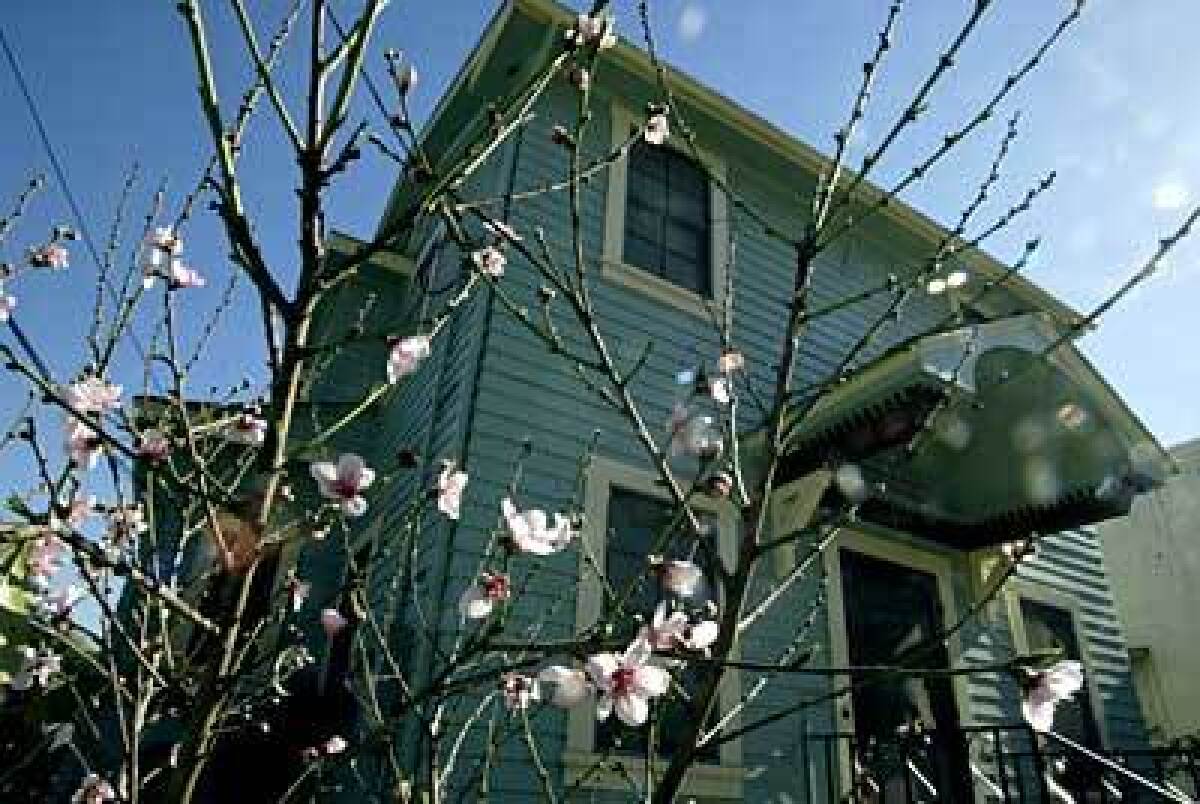Preserving L.A.’s past in Angelino Heights

- Share via
Sunsets in Angelino Heights offer a spectacular view of modern Los Angeles as well as a look at the city’s past. At twilight, antique-looking streetlights cast their beams onto the gingerbread decoration of Victorian homes built in the 1880s.
Hot spot
Many of the homes, particularly on Carroll Avenue, have been restored to their former grandeur and often attract movie crews from Hollywood. Hitching posts and carriage steps at the curbsides remain as vestiges of a neighborhood that also includes Mission Revival, Craftsman, Spanish and Country English homes built for the bankers and real estate developers of centuries past.
Beginnings
The area was developed in the 1880s when William W. Stilson and Everett E. Hall filed for the subdivision of the Angelino Heights tract. Their hope was to attract upper-middle-class buyers who wanted to be near the city center but away from its bustle. A nearby cable car line, which ran down Temple Street, enabled residents to travel downtown in minutes. After a recession in 1888, construction slowed.
Turning point
Beginning in the 1970s, residents began taking an interest in preserving the neighborhood’s historic structures. Carroll Avenue is now listed on the National Register of Historic Places.
In 1983, Angelino Heights was declared the city’s first historic preservation overlay zone. The designation gives homeowners property tax relief under the Mills Act, a benefit that can be passed on to buyers. Homeowners in the zone must get permission from a city committee to paint home exteriors and do other outside work.
“People feel protected because the neighbors can only do certain things to their houses. Everyone wants to be in this zone. It has cleaned up the area,” said Henni Bouwmeester, an agent with DBL Realtors. “People find this neighborhood and they feel they have really discovered something.”
Local geography
The triangular-shaped neighborhood of about 500 house- holds is east of Echo Park Lake and north of the 101 Freeway. From the area, there are views of the Hollywood sign, the Griffith Observatory and the lake.
On the market
Homes vary in price from $375,000 to $950,000, depending on size and condition. There are currently two homes on the market — an 892-square-foot, two-bedroom home for $375,000 and a 2,082-square-foot, three-bedroom home with a detached guesthouse for $948,000, according to Richard Stanley, an architectural and historic properties specialist affiliated with Coldwell Banker.
But owning a beautiful old home can mean putting time and money into plumbing, electricity and foundations. Shake roofs must be replaced to meet modern standards. Chimneys may be made with bricks made of beach sand that slowly sifts out and leads to collapse, he said.
“Be prepared to get out your checkbook,” Stanley said. “But in the end, you have a wonderful tax benefit and a distinctive neighborhood.”
Insider’s view
Neighbors remain committed to retaining the area’s character. When a developer proposed condominiums on Carroll Avenue 18 months ago, residents balked, distributing fliers and posting signs to explain what was to happen. Two ended up buying the five lots from the developer and will sell them with restrictions on what can be built, said Daniel Muñoz, president of Angelino Heights Community Organization, formed in 1980. The group is working on historic lighting on Douglas Street, Bellevue Avenue and Kensington Road.
“This is a historic district. People want to visit to see the architecture still intact. So many neighborhoods have been wiped out,” Muñoz said. “There’s a neighborhood feeling that goes back in time. It allows you to visit something from the turn of the century.”
Report card
Betty Plasencia Elementary School, Thomas Starr King Middle School, Virgil Middle School and Belmont High School serve the area. Their scores on the Academic Performance Index in 2004 were 689, 625, 559 and 518 respectively, out of a possible 1,000.
Historical values
Residential resales:
Year...Median Price
1990...$180,0001995...$148,000
2000...$200,000
2003...$311,000
2004...$465,000
Sources: DataQuick Information Systems, you-are-here.com/victorian, api.cde.ca.gov.
More to Read
Sign up for Essential California
The most important California stories and recommendations in your inbox every morning.
You may occasionally receive promotional content from the Los Angeles Times.






